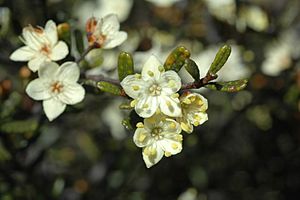Phebalium lepidotum facts for kids
Quick facts for kids Phebalium lepidotum |
|
|---|---|
 |
|
| In Australian National Botanic Gardens | |
| Scientific classification | |
| Genus: |
Phebalium
|
| Species: |
lepidotum
|
| Synonyms | |
Phebalium lepidotum is a type of rounded shrub. It grows only in Western Australia (this is called being endemic). This plant has small, scaly branches and tough, narrow leaves. Its flowers are white or cream-coloured and grow in small bunches called umbels. Each bunch usually has three to six flowers.
What it Looks Like
Phebalium lepidotum is a slim, rounded shrub. It usually grows to be about 0.45 to 1.5 meters (about 1.5 to 5 feet) tall. Its small branches have tiny bumps and are covered with scales.
The leaves are tough and narrow, shaped like a long oval. They are usually 5 to 15 millimeters (about 0.2 to 0.6 inches) long and 1.5 to 2 millimeters (about 0.06 to 0.08 inches) wide. They grow on a short stem called a petiole. The top of the leaves is smooth, but the bottom is covered with shiny, silver scales.
Flowers
The flowers are white or cream-coloured. They grow in small clusters called umbels, with three to six flowers in each cluster. Each flower sits on a thin stem about 5 millimeters (0.2 inches) long.
Each flower has five small leaves called sepals, which are about 1.5 millimeters long. They are joined together for half their length. The outside of the sepals is covered with rust-coloured scales. The petals are wide and oval-shaped, about 4 to 5 millimeters long and 3 to 3.5 millimeters wide. Their backs are also covered with rust-coloured scales. This plant blooms from August to November.
How it Got its Name
This plant was first officially described in 1863. A scientist named Nikolai Turczaninow gave it the name Boronia lepidota. He published his description in a science journal called Bulletin de la Société Impériale des Naturalistes de Moscou. The plants he studied were collected by James Drummond.
Later, in 1970, another scientist named Paul G. Wilson changed the name to Phebalium lepidotum. He published this new name in the journal Nuytsia.
Where it Grows
Phebalium lepidotum can be found in a part of Western Australia. It grows in the area between Merredin, Zanthus, and the southern coast.
Is it Protected?
The Government of Western Australia's Department of Parks and Wildlife has looked at this plant. They have classified Phebalium lepidotum as "not threatened." This means it is not currently in danger of disappearing.

